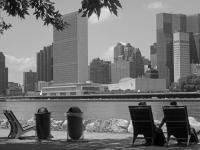Galleria Midobaru
Beppu, Oita, Japan
Site-specific hotel that enhances experience value
This is a hotel that was built in Beppu, a hot spring resort area, as a business owner of Sekiya Resort Group, which was founded in 1900. It stands on a fault scarp that forms the edge of the alluvial fan terrain, and overlooks the Yukemuri (Hot spring steam) cityscape and Beppu Bay. You can enjoy the hot springs and the scenery in each of the 35 rooms. It was planned as a new exchange base for the region, with hot springs and accommodation functions, and opened as public spaces, a "site-specific" architectural space, and artwork by 12 groups of artists as catalysts.
In today's local cities, "homogenization" is progressing, and spaces where you can feel regionality are being lost in many places. We feel that accepting and thinking about it is an important issue for designers. First of all, we began to think of designs from the unique terrain of this area, which was born in geological time. That is because we wanted to realize an architecture that connects with the region, which inspires the thinking of today's new regionality. We envisioned flocking walls carved from the ground of a fault scarp, and made a space where the inside and the outside were connected by making holes in the flocking walls like digging a cave.
This hotel consists of two buildings, the main building is a new building, and the restaurant building is a reconstructed building that utilizes the existing RC building for reduction and extension. The hotel is connected by a semi-outdoor "alley space" where the axes are crossed and connected. When you walk around in the hotel, you will be connected to the scenery framed by the walls and holes, and you will feel the lights and sounds that permeate. It is like a spatial experience of walking in the alley of old downtown of Beppu.
For the flocking of walls, concrete toned with iron oxide components was cast by a "cedar wood formwork" made of local cedar wood. The color tone refers to the support layer and Beppu stone confirmed at the time of boring. We accepted the "phenomena" that occur during the casting process, such as efflorescence, unevenness, and lack of joints, and used them as "scenery." The reason is that we wanted to create an architectural and spatial experience that would lead to the geological time of this place by making the time of formation awakened.
























